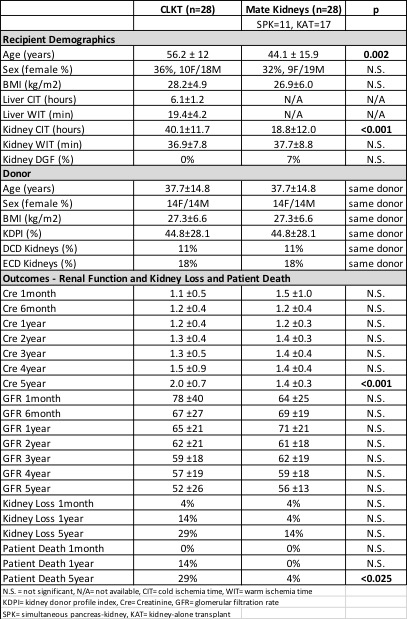Delayed Kidney Transplant (KT) up to 2 Days in Combined Liver-Kidney Transplantation (CLKT) Offers Similar Renal Function as KT Alone: Comparison Analysis with Mate Kidneys
1Division of Transplant Surgery - Indiana University, Indianapolis, IN, 2Division of Nephrology, Indiana University, Indianapolis, IN, 3Division of Nephrology - Indiana University, Indianapolis, IN
Meeting: 2020 American Transplant Congress
Abstract number: 260
Keywords: Kidney/liver transplantation, Liver transplantation, Machine preservation, Outcome
Session Information
Session Name: Kidney Issues in Liver Transplantation
Session Type: Oral Abstract Session
Date: Saturday, May 30, 2020
Session Time: 3:15pm-4:45pm
 Presentation Time: 3:51pm-4:03pm
Presentation Time: 3:51pm-4:03pm
Location: Virtual
*Purpose: Delayed KT in CLKT (Indiana Approach) offers a less hostile environment with hemodynamically more stable patient at the time of KT. Positive impact of delayed KT in CLKT on patient survival and renal function compared to Simultaneous LKT was shown by us and other groups. However, debates continue on the harmful effect of prolonged cold ischemia time (CIT), >48h, on kidneys transplanted as CLKT. We sought to determine whether prolonged CIT affect immediate (delayed graft function [DGF]) and long-term renal function.
*Methods: We compared outcomes of CLKT (n=28) performed using the Indiana Approach (mean kidney CIT 40±12h, range 20-63h) with outcomes of mate kidneys transplanted in our institute (mean kidney CIT 19±12h, range 6-38h, p<0.001). All kidneys supported by oxygenated continuous hypothermic machine perfusion (OCHMP) until KT, regardless of their allocation.
*Results: Out of 28 mate kidneys, 11 (39%) were transplanted as simultaneous pancreas-kidney, and 17 (61%) as KT alone. In CLKT, recipients were older (p=0.002) and kidney CIT was longer (p<0.001) due to delayed KT. Although there was no DGF observed in CLKT, it was not statistically significant due to small numbers. Renal function measured by serum creatinine and estimated glomerular filtration rate (eGFR) calculated by MDRD equation, were similar in both groups, except serum creatinine at 5-year which was higher in CLKT. Immediate (1-month), 1-year, and long-term kidney losses were comparable in both groups. However, we observed more patient death in CLKT at 5-year (p<0.025) (Figure 1).
*Conclusions: Indiana Approach (delayed KT) in CLKT offers similar long-term renal function as KT alone despite the sickest patient population and significantly prolonged CIT. Our results also confirm that kidneys can be safely transplanted with prolonged CIT up to 2 days despite their KDPI, ECD or DCD status, if supported by OCHMP.
To cite this abstract in AMA style:
Ekser B, Taber-Hight E, Mihaylov P, Kubal CA, Mangus RS, Fridell JA, Lutz AJ, Adebiyi O, Taber TE, Sharfuddin A, Yaqub MS, Mishler DP, Anderson MD, Powelson JA, Goggins WC. Delayed Kidney Transplant (KT) up to 2 Days in Combined Liver-Kidney Transplantation (CLKT) Offers Similar Renal Function as KT Alone: Comparison Analysis with Mate Kidneys [abstract]. Am J Transplant. 2020; 20 (suppl 3). https://atcmeetingabstracts.com/abstract/delayed-kidney-transplant-kt-up-to-2-days-in-combined-liver-kidney-transplantation-clkt-offers-similar-renal-function-as-kt-alone-comparison-analysis-with-mate-kidneys/. Accessed November 27, 2025.« Back to 2020 American Transplant Congress

